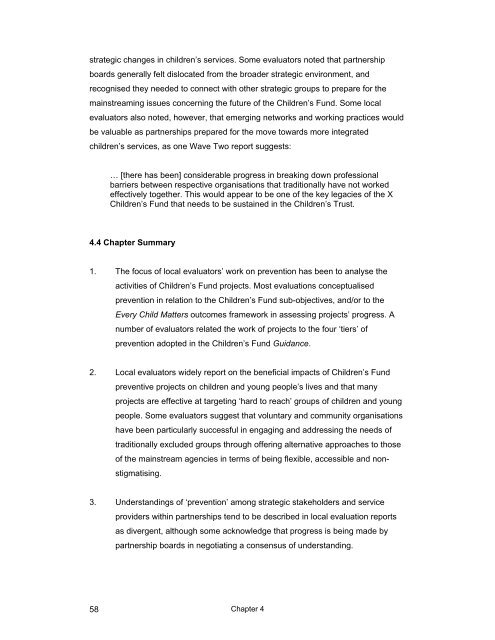Local Evaluation of Children's Services Learning from the Children's ...
Local Evaluation of Children's Services Learning from the Children's ...
Local Evaluation of Children's Services Learning from the Children's ...
- No tags were found...
Create successful ePaper yourself
Turn your PDF publications into a flip-book with our unique Google optimized e-Paper software.
strategic changes in children’s services. Some evaluators noted that partnershipboards generally felt dislocated <strong>from</strong> <strong>the</strong> broader strategic environment, andrecognised <strong>the</strong>y needed to connect with o<strong>the</strong>r strategic groups to prepare for <strong>the</strong>mainstreaming issues concerning <strong>the</strong> future <strong>of</strong> <strong>the</strong> Children’s Fund. Some localevaluators also noted, however, that emerging networks and working practices wouldbe valuable as partnerships prepared for <strong>the</strong> move towards more integratedchildren’s services, as one Wave Two report suggests:… [<strong>the</strong>re has been] considerable progress in breaking down pr<strong>of</strong>essionalbarriers between respective organisations that traditionally have not workedeffectively toge<strong>the</strong>r. This would appear to be one <strong>of</strong> <strong>the</strong> key legacies <strong>of</strong> <strong>the</strong> XChildren’s Fund that needs to be sustained in <strong>the</strong> Children’s Trust.4.4 Chapter Summary1. The focus <strong>of</strong> local evaluators’ work on prevention has been to analyse <strong>the</strong>activities <strong>of</strong> Children’s Fund projects. Most evaluations conceptualisedprevention in relation to <strong>the</strong> Children’s Fund sub-objectives, and/or to <strong>the</strong>Every Child Matters outcomes framework in assessing projects’ progress. Anumber <strong>of</strong> evaluators related <strong>the</strong> work <strong>of</strong> projects to <strong>the</strong> four ‘tiers’ <strong>of</strong>prevention adopted in <strong>the</strong> Children’s Fund Guidance.2. <strong>Local</strong> evaluators widely report on <strong>the</strong> beneficial impacts <strong>of</strong> Children’s Fundpreventive projects on children and young people’s lives and that manyprojects are effective at targeting ‘hard to reach’ groups <strong>of</strong> children and youngpeople. Some evaluators suggest that voluntary and community organisationshave been particularly successful in engaging and addressing <strong>the</strong> needs <strong>of</strong>traditionally excluded groups through <strong>of</strong>fering alternative approaches to those<strong>of</strong> <strong>the</strong> mainstream agencies in terms <strong>of</strong> being flexible, accessible and nonstigmatising.3. Understandings <strong>of</strong> ‘prevention’ among strategic stakeholders and serviceproviders within partnerships tend to be described in local evaluation reportsas divergent, although some acknowledge that progress is being made bypartnership boards in negotiating a consensus <strong>of</strong> understanding.58Chapter 4
















